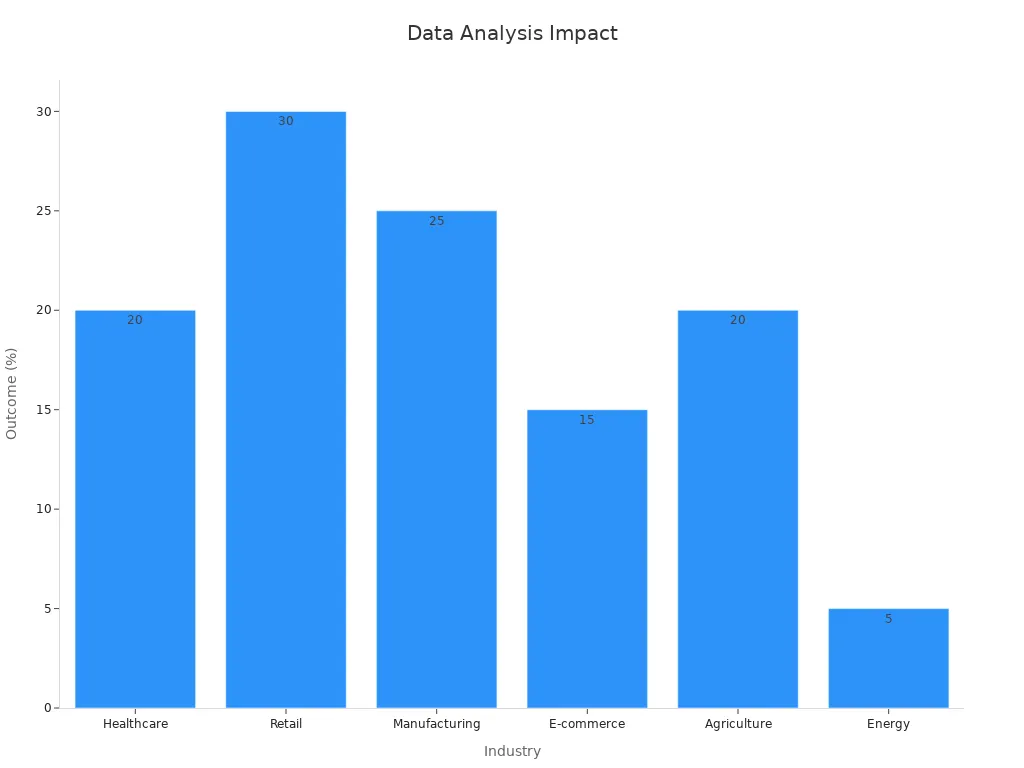Designing a Feedback Loop for Dynamic ETA & Capacity Re-Planning

A feedback loop is a system that continuously collects data, analyzes it, and uses the insights to refine processes. In dynamic ETA and capacity re-planning, it enables real-time adaptability by responding to changing conditions. This approach ensures operational efficiency, as seen in studies that measured cost-efficiency improvements across industries. For example, research on bank mergers and branch operations highlights how iterative adjustments enhance performance. By using a feedback loop, you can transform static systems into agile frameworks capable of handling complex demands.
Key Takeaways
A feedback loop gathers and studies data to make things better. This helps improve how work is done and decisions are made.
Collecting good data is very important. Use different sources and reliable ways to get correct information for better ideas.
Use ideas to take action. Clear teamwork and sharing help make changes easy and successful.
Testing again and again helps improve the feedback loop. Check and fix processes often to keep up with changes.
Create a culture that values feedback. Support open talks and regular feedback to build trust and make the organization flexible.
Key Components of a Feedback Loop

Data Collection and Sources
Data collection forms the foundation of any feedback loop. You need to gather accurate and timely data from diverse sources to ensure the system works effectively. For example, in dynamic systems like climate change, carbon release creates a positive feedback loop that accelerates global warming. Similarly, predator-prey dynamics in ecology demonstrate how population fluctuations influence each other cyclically. These examples highlight the importance of capturing data that reflects real-world interactions.
To achieve this, you can rely on methods such as high-quality data collection and surveys across multiple platforms. A study comparing data collection methods found that robust feedback mechanisms lead to broader organizational impacts. Here's a quick look at the outcomes:
Data Collection Method | Outcome | Impact |
|---|---|---|
High-quality data collection | Better learning | Broader organizational impacts |
Surveys on various platforms | More robust feedback | More impactful change |
Listening to stakeholders, reflecting on their feedback, and acting on it can further enhance the quality of your data.
Data Analysis and Insights Generation
Once you collect the data, analyzing it becomes the next critical step. This process transforms raw information into actionable insights. Industries like healthcare and retail have demonstrated the power of data analysis. For instance, a hospital network reduced readmission rates by 20% by adjusting treatment protocols based on real-time data. Similarly, a fashion retailer increased sales by 30% by predicting trends and optimizing inventory.

These examples show how effective data analysis can lead to measurable improvements. By leveraging advanced tools and algorithms, you can uncover patterns, predict outcomes, and make informed decisions.
Actionable Adjustments and Execution
The final step in the feedback loop involves turning insights into actions. This stage ensures that the system adapts to changing conditions in real time. For example, urban planners have used sensor data to adjust traffic signal timings, reducing commute times by 10 minutes on average. Similarly, energy providers have balanced load distribution using consumption data, leading to a 5% reduction in peak demand.
To execute these adjustments effectively, you must prioritize clear communication and collaboration across teams. Explain why changes are being made and how they align with broader goals. This approach not only ensures smooth implementation but also fosters trust and accountability within your organization.
Designing the Feedback Loop

Identifying Relevant Data Sources
The first step in designing an effective feedback loop is identifying the right data sources. You need to focus on sources that provide accurate, timely, and actionable information. For instance, governments and organizations have successfully implemented feedback loops by leveraging diverse data streams.
The UK's Climate Change Act established a system to monitor greenhouse gas emissions. It required setting carbon budgets and reporting progress regularly.
The US Medicare Part D Program used surveys and claims data to assess its impact. This approach enabled continuous adjustments to improve outcomes.
These examples highlight the importance of selecting data sources that align with your goals. You should also consider the type of data you need—quantitative, qualitative, or a mix of both. By doing so, you ensure that your feedback loop captures the full picture and supports informed decision-making.
Recent thinking emphasizes the need for interaction between project designers, implementers, and decision-makers. This approach promotes adaptation through learning and timely assessments, providing actionable feedback to achieve intended outcomes.
Integrating Algorithms for Real-Time Adjustments
Once you have the data, integrating algorithms into your feedback loop allows for real-time adaptability. Algorithms process incoming data, identify patterns, and suggest adjustments. This capability is especially useful in dynamic environments where conditions change rapidly.
Feedback loops improve model accuracy through iterative refinement.
Systematic feedback reduces miscommunication and guides teams effectively.
Consistent feedback enhances AI models by addressing errors quickly.
For example, machine learning systems use feedback loops to connect predictions back into the system. This process retrains models, enabling real-time adaptation and error correction. In industries like e-commerce and fraud detection, this approach ensures that systems remain responsive and effective.
Feedback loops in machine learning facilitate real-time streaming, scalability, and durability. These features allow systems to handle large-scale data streams while ensuring data persistence for retraining models.
By integrating algorithms, you can create a feedback loop that not only adapts to changes but also improves over time. This iterative process ensures that your system remains robust and reliable.
Iterative Testing and Improvement
Testing and refining your feedback loop is crucial for long-term success. Iterative testing allows you to identify weaknesses, optimize processes, and enhance performance. You can use various methods to achieve this:
Automated testing, such as unit tests and integration tests, provides rapid feedback.
Deployment metrics, including lead time and change failure rate, help you monitor performance.
User experience monitoring tracks behavior and performance to gauge effectiveness.
A/B testing collects and analyzes data to inform future actions.
Multivariate testing identifies optimal combinations for desired outcomes.
These methods ensure that your feedback loop evolves with changing conditions. For example, systems that use A/B testing can pinpoint successful strategies and optimize outcomes. This approach not only improves efficiency but also fosters innovation.
The lack of a systematic process for linking ongoing learnings to project modifications often limits adaptability. A well-designed feedback loop addresses this gap, enabling programs to respond to complex and unpredictable challenges.
By prioritizing iterative testing, you create a feedback loop that continuously learns and adapts. This process ensures that your system remains effective, even in the face of uncertainty.
Implementation Strategies for Feedback Loops
Leveraging Tools and Technologies
Using the right tools and technologies can significantly enhance the effectiveness of your feedback loop. Tools like data analytics platforms, machine learning algorithms, and real-time dashboards allow you to process and analyze data efficiently. For example, HubSpot demonstrated how integrating employee feedback into decision-making processes increased project success rates by 30%. Similarly, Starbucks' "Partner Pulse" survey fostered open dialogue with employees, boosting customer satisfaction scores by 10%. These examples highlight how technology can bridge the gap between feedback collection and actionable insights.
You can also explore participatory approaches when implementing new tools. EasyJet involved its cabin crew during the development of new technology, which led to a 20% increase in staff productivity. This participatory model ensures that the tools you adopt align with the needs of your team, making them more effective and widely accepted.
Tip: Start small by piloting tools in specific departments. Gather feedback on their performance and refine your approach before scaling up.
Building Cross-Functional Collaboration
Collaboration across teams is essential for a successful feedback loop. When teams work together, they can share insights, address challenges, and implement changes more effectively. Models like the BizDevOps approach integrate business, development, and operations teams to streamline feedback processing. This integration ensures that feedback flows seamlessly from one team to another, enabling timely responses and better decision-making.
Here are some strategies to enhance cross-functional collaboration:
Automate the transfer of user feedback from customer support to engineering teams.
Centralize feedback using integrated tools to give all teams access to user insights.
Use frameworks like RICE scoring to prioritize feedback based on its impact.
Combine operational insights with user feedback for proactive issue resolution.
By fostering collaboration, you create a unified approach to feedback management. This not only improves the efficiency of your feedback loop but also builds a culture of shared responsibility and continuous improvement.
Note: Regular cross-team meetings can help align goals and ensure everyone stays informed about feedback-driven changes.
Ensuring Scalability and Flexibility
A scalable and flexible feedback loop adapts to growth and changing conditions without losing effectiveness. To achieve this, focus on creating systems that can handle increasing amounts of data and feedback. For instance, employees who receive regular feedback report higher job satisfaction and engagement, according to a study in the Journal of Occupational and Organizational Psychology. These employees are more likely to stay with their employer, reducing turnover costs and preserving institutional knowledge.
Dynamic planning plays a crucial role in scalability. Revisiting and adapting initiatives based on lessons learned ensures continuous improvement. Embedding feedback into your organization's infrastructure and routines, as seen in K-12 education, creates a dynamic environment that supports growth. This approach allows you to adjust your strategies as new challenges and opportunities arise.
Tip: Monitor success metrics regularly to identify areas for improvement. Use these insights to refine your feedback loop and maintain its scalability.
Sustaining the Feedback Loop
Continuous Monitoring and Optimization
Continuous monitoring ensures your feedback loop remains effective over time. By tracking real-time data, you can identify trends, pinpoint issues, and implement timely improvements. For example, automated alerting systems notify you when metrics exceed predefined thresholds, allowing you to address problems before they escalate. Performance benchmarking helps you compare current outcomes against established standards, revealing areas that need attention.
Trend analysis plays a vital role in optimization. It allows you to spot recurring patterns and adjust strategies accordingly. Root cause analysis further enhances this process by correlating data to uncover underlying issues. For instance, a bank improved its operational efficiency by integrating feedback from stakeholders and analyzing deployment metrics. This iterative approach ensures your system evolves to meet changing demands.
Tip: Regularly review feedback and performance data to identify opportunities for improvement. Use these insights to refine your feedback loop and maintain its effectiveness.
Adapting to Changing Conditions
Feedback loops excel at adapting to dynamic environments. Controllers can monitor quality requirements in real-time and adjust strategies to align with business goals. For example, a web server farm uses a secondary feedback loop to handle sudden spikes in internet traffic. This system reacts quickly to short-term changes while fine-tuning its control strategy based on long-term trends.
Self-adaptive systems rely on feedback loops to execute MAPE (Monitor, Analyze, Plan, Execute) processes. These processes enable you to respond to gradual shifts in operational conditions. By implementing adaptive control methods, you can ensure your system remains resilient and responsive. This flexibility allows you to make trade-offs that balance immediate needs with long-term objectives.
Note: Incorporate self-tuning mechanisms into your feedback loop to enhance adaptability and align system performance with evolving requirements.
Fostering a Feedback-Driven Culture
A feedback-driven culture empowers your organization to adapt swiftly to challenges. By capturing employee sentiments through tools like pulse surveys and sentiment analysis, you can align change initiatives with their expectations. This approach fosters transparency and trust, creating an environment where continuous improvement thrives.
Organizations that prioritize feedback loops often experience higher resilience and adaptability. For instance, companies that integrate employee feedback into decision-making processes report improved alignment with transformation goals. This culture not only enhances operational efficiency but also prepares your team to tackle future demands effectively.
Tip: Encourage open dialogue and regular feedback sessions to build a culture of trust and collaboration. This practice ensures your organization remains agile and ready for change.
Overcoming Challenges in Feedback Loop Design
Managing Data Overload
Handling large volumes of data can feel overwhelming, especially when feedback comes from multiple sources. You might struggle to identify and prioritize critical insights, leading to fragmented understanding. To manage this, focus on organizing and categorizing feedback for easier navigation. Self-service platforms can help you access insights quickly, while AI and automation tools process data efficiently. For example, automated analysis tools scale with your needs, ensuring you don’t lose valuable insights as data grows.
Streamlining collaboration also prevents the loss of important information. Encourage teams to share findings regularly and centralize feedback in one accessible location. By establishing continuous feedback loops, you can refine your data collection methods over time. This approach ensures that your system remains manageable and effective, even as the volume of data increases.
Addressing Bias in Predictions
Bias in predictions can distort outcomes and reduce the effectiveness of your feedback loop. For instance, prediction error scores measure the gap between expected and actual results, while control error scores assess how far outcomes deviate from the best possible scenario. These metrics highlight areas where bias may exist. You can use statistical methods like ANOVA to analyze these discrepancies and identify patterns.
To minimize bias, ensure your data sources are diverse and representative. Regularly retrain algorithms with updated data to reduce inaccuracies. Incorporating human oversight into the decision-making process also helps balance machine-driven predictions. By addressing bias proactively, you improve the reliability of your system and build trust in its outputs.
Overcoming Resource Constraints
Resource constraints often limit the implementation of feedback loops. You can address this by identifying leading indicators, such as response latency or resource consumption patterns, to predict instability. Dynamic guardrails, which adapt to changing conditions, protect sensitive operations. For example, creating resource pools with similar skill sets increases flexibility and ensures critical tasks are covered.
A digital management system can streamline operations and improve efficiency. Additionally, progressive learning techniques, like transfer learning, allow systems to adapt incrementally across different conditions. This ensures resilience and reduces the strain on resources. Regularly reviewing operational processes and developing contingency plans further strengthens your ability to manage constraints effectively.
Tip: Benchmark your processes against competitors to identify best practices and optimize resource allocation.
Designing a feedback loop involves collecting data, analyzing it, and making actionable adjustments. These steps create a system that adapts to real-time changes and improves over time. By implementing this approach, you can enhance operational efficiency and make better decisions. Dynamic ETA and capacity re-planning benefit greatly from this adaptability, helping you respond to challenges effectively.
Adopting a feedback loop fosters continuous improvement and prepares your organization for future demands. Start small, refine your process, and watch your systems evolve into more agile and efficient frameworks.
FAQ
What is a feedback loop in dynamic ETA and capacity re-planning?
A feedback loop collects data, analyzes it, and adjusts processes in real time. It helps you adapt to changing conditions, ensuring accurate ETAs and efficient capacity management. This system improves decision-making and operational performance.
How do algorithms enhance feedback loops?
Algorithms process data quickly, identify patterns, and suggest adjustments. They enable real-time adaptability, making your system responsive to changes. For example, machine learning algorithms retrain models using feedback, improving accuracy and efficiency over time.
What tools can help implement a feedback loop?
You can use data analytics platforms, real-time dashboards, and machine learning tools. These technologies streamline data collection and analysis. For instance, AI tools automate insights, while dashboards provide a clear view of performance metrics.
Tip: Start with tools that integrate easily into your existing systems.
How can you address bias in feedback loop predictions?
Use diverse data sources and retrain algorithms regularly. Human oversight also helps balance machine-driven predictions. These steps reduce inaccuracies and improve trust in your system’s outputs.
Why is scalability important in feedback loops?
Scalability ensures your feedback loop handles growth and changing conditions. A scalable system adapts to increasing data volumes without losing effectiveness. This flexibility supports long-term success and operational resilience.
Emoji Insight: 🚀 Scalability keeps your system future-ready!
See Also
Effective Strategies for Retail Demand Forecasting Each Week
Four Automated Algorithms for Large-Scale Daily Replenishment
Achieving Quick Turns While Avoiding Stockouts: Key Metrics
Techniques and Challenges in Short-Term Demand Forecasting
Creating a Data-Centric Stage-Gate Process for Retail Launches
